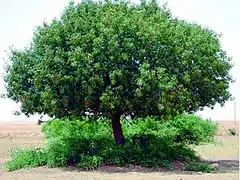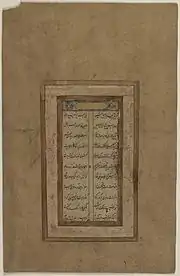Sidrat al-Muntaha
The '''Sidra tul-Muntaha''' (Arabic: سِدْرَة ٱلْمُنْتَهَىٰ, romanized: Sidratul-Muntahā, lit. 'Lote Tree of the Farthest Boundary') is a large lote tree or Sidr tree[1] that marks the utmost boundary in the seventh heaven, which no one can pass. It is called Sidrat al-Muntaha because the knowledge of the angels stops at that point, and no one has gone beyond it. During the Isra and Mi'raj, Muhammad traveled with the angel Gabriel to the tree where Gabriel stopped. Beyond the tree, Allah instructed Muhammad about the five daily prayers.[2]


The Sadratu'l-Muntahá is also used to refer to the Manifestation of God a number of times in the Bahá’í Writings.[3]
Quran
The tree is also referred to in Sura 53 verse 14–16, Sura 34 verse 16 and Sura 56, verse 28.
Sura 53, verses 11-18 reads:
11. The ˹Prophet’s˺ heart did not doubt what he saw.
12. How can you ˹O pagans˺ then dispute with him regarding what he saw?
13. And he certainly saw that ˹angel descend˺ a second time
14. at the Lote Tree of the most extreme limit ˹in the seventh heaven˺—
15. near which is the Garden of ˹Eternal˺ Residence—
16. while the Lote Tree was overwhelmed with ˹heavenly˺ splendours!
17. The ˹Prophet’s˺ sight never wandered, nor did it overreach.
18. He certainly saw some of his Lord’s greatest signs.
Sura 34, verses 15-17 reads:
15. There was a sign for the people of Sheba, too, in their dwelling place: two gardens, one on the right, one on the left: ‘Eat from what your Lord has provided for you and give Him thanks, for your land is good, and your Lord most forgiving.’
16. But they paid no heed, so We let loose on them a flood from the dam and replaced their two gardens with others that yielded bitter fruit, tamarisk bushes, and a few lote trees.
17. In this way We punished them for their ingratitude- would We punish anyone but the ungrateful?
Sura 56, verses 27-34 reads:
27. And the people of the right—how ˹blessed˺ will they be!
28. ˹They will be˺ amid thornless lote trees,
29. clusters of bananas,
30. extended shade,
31. flowing water,
32. abundant fruit—
33. never out of season nor forbidden—
34. and elevated furnishings.
Meaning
A Qur'an commentary entitled Tafsīr al-karīm al-raḥman fī tafsīr kalām al-manān by Abd ar-Rahman ibn Nasir as-Sa'di, while commenting on Quran 53:14, the Sidrat al-Muntahā, (Lote-Tree of the Extremity) explained:[4]
It [the Sidrat al-Muntahā] is a very large Tree (شَجَرَة - shajarah) beyond the 7th heaven. It is named the Sidrat al-Muntahā because there terminates at it whatever ascends from the earth and whatever descends [from heaven] including what comes down from God, including waḥy (divine inspiration) and other things besides. Alternatively, [it might be said that this name is because] it is the Uttermost Extremity or the very end of something [or Boundary] (اِنْتِهاء - intihā' which is one of the many Arabic words for the word end) for the knowledge of the creatures approaching it, relative, that is, to its Existent Being [as located] above the heavens and the earth. So it is al-Muntahā (the Extremity, Boundary) with respect to [all human] modes of knowledge (عُلُوم - ʻulūm) or other things besides. And God is best informed [of this matter]. Thus [it was that] Muhammad saw Gabriel in that location (الْمَكَان - al-makān) which is the Domain of the Pure and Beautiful, Elevated [celestial] Souls (مَحَلُّ الْأَرْوَاحُ الْعُلُوِيَّةُ الْزَّكِيَّةُ الْجَمِيلِيَّة - maḥall al-arwāḥ al-ʻuluwiyyah al-zakiyyah al-jamīliyyah)...
— (As-Saʻdi, Tafsir, 819).[4]
Abdullah Yusuf Ali, whose The Holy Qur'an: Text, Translation and Commentary is among the most widely known English versions of the Qur'an,[5] explained that this tree "marked the bounds of heavenly knowledge as revealed to men, beyond which neither Angels nor men could pass."[6]
George Sale, the 18th century English scholar, has "beyond which Angels themselves must not pass; or, as some rather imagine, beyond which no creature's knowledge can extend."[7] Sale also notes that one commentator states that line 16 refers to the "host of angels worshipping" around the tree[8] and another that it is about the birds which sit on its branches.[9]
The 19th-century English explorer Richard Burton reported seeing an ancient Sidr tree in Al-Masjid Al-Nabawi in Madinah. It was in a garden dedicated to Hazrat Sayyida Fatima, may Allah's blessings upon her. The fruit from the tree was being sold to pilgrims and its leaves used for washing dead bodies.[10]
Use as a symbol
The lote-tree is used as a symbol, for example, by the Qatar Foundation: "The Sidra tree, growing strong and proud in the harshest of environments, has been a symbol of perseverance and nourishment across the borders of the Arab world. What is the significance of this glorious tree? With its roots bound in the soil of this world and its branches reaching upwards toward perfection, it is a symbol of solidarity and determination; it reminds us that the goals of this world are not incompatible with the goals of the spirit." The evergreen tree Ziziphus spina-christi represents this symbol in natural form.[11]
See also
References
- Quran 53:14
- El-Sayed El-Aswad. Religion and Folk Cosmology: Scenarios of the Visible and Invisible in Rural Egypt. Praeger/Greenwood. United States: 2002. p. 84. ISBN 0-89789-924-5
- Bayat, Ehsan (2003). "Sadratu'l-Muntahá by The Báb, Bahá'u'lláh, Abdu'l-Bahá, and The Qur'án". Retrieved February 9, 2023.
{{cite journal}}: Cite journal requires|journal=(help) - Lambden, Stephen. (2009). The Sidrah (Lote-Tree) and the Sidrat al-Muntaha (Lote-Tree of the Extremity).
- Mohammed, Khaleel (Spring 2005). "Assessing English Translations of the Qur'an". Middle East Quarterly. Middle East Forum. 12 (2): 58–71. Retrieved 22 Oct 2015.
- Abdullah, Yusuf Ali (1946) The Holy Qur-an: Text, Translation and Commentary, Qatar National Printing Press. p.1139,n.3814
- Sale, George (n.d.) The Koran" Sir John Lubbock's hundred books. George Routledge and sons, London. p.323 note r
- Ahmad al-Badawi, p. 323 note 1
- Rumi' p. 323' note 2
- Burton, Richard Francis (1855). A Personal Narrative of a Pilgrimage to Al-Madinah and Makkah. Project Gutenberg. p. 337. Retrieved 8 July 2016.
- Sheikha Moza bint Nasser, Qatar Foundation Chairperson (13 October 2003). "The Sidra Tree Story". Qatar Foundation - About.
Further reading
- Ayoub, Mahmoud. The Qur'an and Its Interpreters: The House of 'Imran. SUNY Press. Albany, NY: 1992. ISBN 0-7914-0993-7
- Lambden, Stephen. Biblical, Islamic and Babi-Baha'i Studies: Section "Sidrat al-Muntaha".